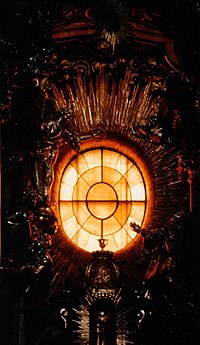
Cosmas Damian Asam was a German painter and architect during the late Baroque period. Born in Benediktbeuern, he lived in Rome from 1711 to 1713 to study at the Accademia di San Luca with Carlo Maratta. In 1713, Asam won the Academy's first prize for his drawing of Miracle of Saint Pio. In Germany, he worked with his brother Egid Quirin, a sculptor and stucco worker, on building and decorating entirely new churches or redesigning churches in the Baroque style. Their joint projects are often attributed to the "Asam Brothers". Cosmas Damian died in Munich.

Bavarians are an ethnographic group of Germans of the Bavaria region, a state within Germany. The group's dialect or speech is known as the Bavarian language, native to Altbayern, roughly the territory of the Electorate of Bavaria in the 17th century.

St. Johann Nepomuk, better known as the Asam Church, is a Baroque church in Munich, southern Germany. It was built from 1733 to 1746 by a pair of brothers, sculptor Egid Quirin Asam and painter Cosmas Damian Asam, as their private church. It is considered to be one of the most important buildings of the southern German Late Baroque.

Johann Michael Fischer was a German architect in the late Baroque period.

Břevnov Monastery is a Benedictine archabbey in the Břevnov district of Prague, Czech Republic. It was founded by Saint Adalbert, the second Bishop of Prague, in 993 AD with the support of Bohemian Duke Boleslaus II. The first Benedictine male monastery in Bohemia, it also has the oldest tradition of beer brewing in the Czech Republic. Brewing was interrupted several times in the history, but up to today, the Břevnov Monastery Brewery brew its beer here.

François Roettiers (1685–1742) was a Flemish Baroque painter, sculptor, medallist and engraver from the early 18th century, who worked mainly in Austria.

Freising Cathedral, also called Saint Mary and Corbinian Cathedral, is a romanesque basilica in Freising, Bavaria. It is the co-cathedral of the Catholic Archdiocese of Munich and Freising. Freising Cathedral is also known for being the place where Pope Benedict XVI was ordained a priest.

The Upper Swabian Baroque Route is a tourist theme route through Upper Swabia, following the themes of "nature, culture, baroque". The route has a length of about 500 km. It was established in 1966, being one of the first theme routes in Germany. There is an extension to the route into Switzerland and Austria around Lake Constance.

Egid Quirin Asam was a German plasterer, sculptor, architect, and painter. He was active during the Late Baroque and Rococo periods.
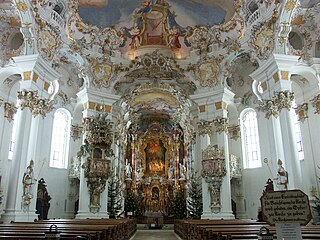
The Wessobrunner School is the name for a group of Baroque stucco-workers that, beginning at the end of the 17th century, developed in the Benedictine Wessobrunn Abbey in Bavaria, Germany.

Fürstenfeld Abbey is a former Cistercian monastery in Fürstenfeldbruck, Bavaria, Germany.

Matthäus Günther was an important German painter and artist of the Baroque and Rococo era.

Johann Baptist Zimmermann was a German painter and a prime stucco plasterer during the Baroque.
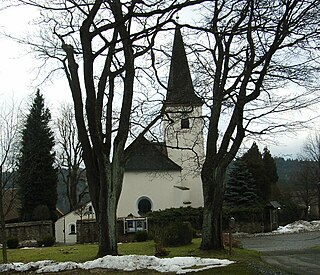
Stadlern is a municipality in the district of Schwandorf in Bavaria, Germany.

The Mannheim Jesuit Church is a Catholic church of historic and artistic importance in Mannheim, Germany. Church construction was begun in 1733 and completed in 1760. It was consecrated to St. Ignatius of Loyola and St. Francis Xavier. During the Second World War, the church suffered severe damage from air attacks; after the war it was rebuilt in its historical style using original parts.
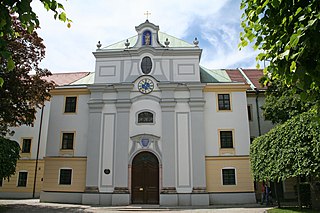
Klosterkirche St. Anna im Lehel is a Catholic abbey church in Munich, Germany. It was the first Rococo church of Old Bavaria and shaped the development of religious architecture in Bavaria. It is located in the center of Lehel opposite to the neo-romanesque Catholic parish church of St. Anna im Lehel.

Innsbruck Cathedral, also known as the Cathedral of St. James, is an eighteenth-century Baroque cathedral of the Roman Catholic Diocese of Innsbruck in the city of Innsbruck, Austria, dedicated to the apostle Saint James, son of Zebedee. Based on designs by the architect Johann Jakob Herkomer, the cathedral was built between 1717 and 1724 on the site of a twelfth-century Romanesque church. The interior is enclosed by three domed vaults spanning the nave, and a dome with lantern above the chancel. With its lavish Baroque interior, executed in part by the Asam brothers, St. James is considered among the most important Baroque buildings in the Tyrol.
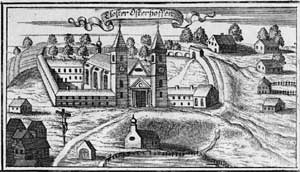
Osterhofen Abbey is a former monastery in Bavaria, Germany, It is located in the Altenmarkt section of Osterhofen, a town to the south of the Danube between Deggendorf and Vilshofen / Passau. It has its origins in a collegiate built in 1004–09. From 1128 to 1783 it was a Premonstratensian monastery. For a while it was then a convent. Today it contains a girls' secondary school. The former abbey church, a magnificent late baroque building erected in 1726–40, is now the Basilica of Saint Margaret.
Asam is a surname. Notable people with the surname include:

Sendlinger Straße is an important shopping street in Munich's city center. It extends into the Munich old town in the south-east-northeast direction from the Sendlinger Tor in the west to the point where Fürstenfelder Straße and the Rindermarkt meet in the east. In July 2016, the conversion from a one-way street into a pedestrian zone was attempted.

